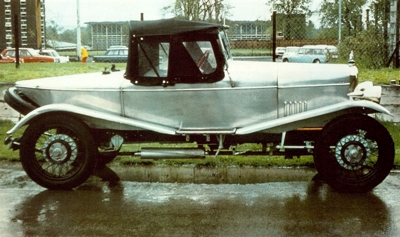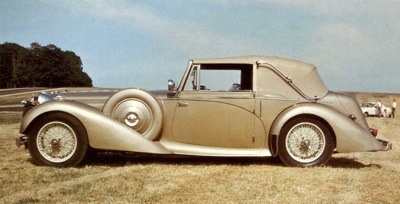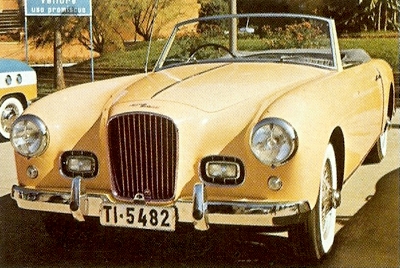|
Alvis
|
1919
- 1967 |
Country: |
 |
|
OF THE MANY new makes of British motor car appearing shortly after World War 1, most were 'assembly jobs' using proprietary engines and other bought components. Two major exceptions (at least as far as Unique Cars and Parts is concerned) were Alvis and Bentley; both fitted engines of their own design and manufacture and, in the long distance international races of the 1920-30 period, Alvis came nearer than any other British make in the 1½ liter class to emulating Bentley achievements in the big car category.
G. P. H. de Freville
The two marques even had a tenuous common background in the small French DFP car, as the designer of the first Alvis, G. P. H. de Freville, had been manager before the war of Bentley & Bentley in Hanover Street, London. That is where W. O. Bentley and his brother H. M., both then in their mid-twenties, had just entered the motor trade and successfully sold DFPs on the strength of W. O.'s competition successes with these cars.
The Genius of Thomas George John
The 12-15 hp DFP was a sporting, lively, well-made car, characteristics that both W. O. Bentley and de Freville bore in mind when designing, respectively, the 3-liter Bentley and 10/30 hp Alvis cars. The presiding genius of Alvis was a Welshman called Thomas George John, who had founded the Coventry firm of T. G. John Limited in March 1919, at the age of 39.
When only 31, as a practising marine engineer, he had managed Armstrong-Whitworth's Barrow-in-Furness Shipbuilding Department. During the war he had turned to aviation engineering, being Works Manager of Siddeley-Deasy at Coventry at a time when they were producing Siddeley 'Puma' aircraft engines.
In forming his own company, John took over premises at 17 Hertford St, Coventry, from the Holley Brothers, the American carburetor manufacturers. Initially he continued with carburetor work, moving on to produce 'Electra' single and twin cylinder stationary engines and 50 cc Stafford Mobile Pup scooters, and doing sub-contract work for Indian motor cycles. The Alvis car was born when John bought the drawings of the 10/30 hp from de Freville together with the name, which de Freville had first used as a trade mark when he was manufacturing light alloy pistons during the war.
Silver At The 1920 London-Edinburgh Trial
After he had driven a 10/30 in the 1920 London-Edinburgh Trial (and won a silver medal in what was the make's debut in a major competition) de Freville himself faded out of the picture so far as Alvis were concerned. There was nothing unconventional about the rather expensive, high quality, side-valve, 1460 cc 10/30 Alvis. Like nearly all its contemporaries, it did not have front-wheel brakes, although the two-seater versions were fitted with .the interesting and very light Morgan 'Zephyr' steel wire-braced all metal bodywork built on lines reminiscent of the construction of the later Italian Zagato coachwork.
A contemporary owner described his 10/30 as extremely 'hot' (it would do around 60 mph) and 'above the run of average cars'. In 1921 T. G. John Limited moved to Holyhead Road, Coventry, and the name of the firm was changed to the Alvis Car & Engineering Company Limited. The factory included offices, two machine shops, assembly and finishing shops and a foundry, although the cylinder heads and blocks had to be bought out at this time. A much lightened 10/30 was entered for the 1921 Coupe des Voiturettes race at Le Mans, driven by the works driver Major C. M. Harvey. Although lying handily behind the three eventually victorious Talbot-Darracqs after only four laps, Harvey then had to retire due to a stone cracking his sump.
In the Brooklands 200 Miles Race, two streamlined 10/30 cars averaged only 65.57 mph and 56.17 mph for the race, although Harvey, in the faster car, was said to have lapped at 87 mph in practice. In 1922 Alvis attempted to enter the bread-and-butter market by manufacturing a reasonably civilised version of the pre-war V-twin air-cooled Buckingham cyclecar, but this did not last very long, output mainly being concentrated on the 10/30 and the bigger bore 1598 cc 11/40 hp, introduced at the 1921 Motor Show, and reclassified as the 12/40 hp.
Production was about a dozen cars a week. The most significant move in 1922 was the appointment of Captain G. T. Smith-Clarke as Chief Engineer and W. M. Dunn as Chief Designer, John henceforth devoting himself to the business side of the Company. Smith-Clarke's genius could be briefly summed up in the citation which went with the award of the James Clayton engineering prize to him in 1957 (three years before his death), to mark his work in '
the development of mechanisms used in connection with astronomical telescopes and for his services in the field of aero engines and automobile engineering in addition to that on mechanical breathing apparatus'.
 1926 Alvis 12/50 with "Duck Back" bodywork.
1926 Alvis 12/50 with "Duck Back" bodywork.
 1940 Alvis Speed 20 Drophead Coupe.
1940 Alvis Speed 20 Drophead Coupe.
 1964 Alvis Tourer, with elegant bodywork by Swiss Graber.
1964 Alvis Tourer, with elegant bodywork by Swiss Graber. |
One Of The Classic Designs Of The Time
Smith-Clarke, in addition to his contributions to astronomical and hospital equipment research, was also a pioneer in the early days of radio, and experimented in 1923 with radio communication between racing cars and the pit. 'We cannot but consider it one of the classic designs of the time, and it remains of all Vintage sports cars the one which needs least apology.' So wrote Clutton and Stanford of the 12/50 Alvis in their book The Vintage Motor Car. The 12/50, which was a development of the earlier Alvis models but fitted with a pushrod overhead valve 1496 cc engine, was the work of Smith-Clarke and Dunn. It put itself on the motoring map when a tuned and lightened version, driven by Maurice Harvey, won the classic 200 Miles Race at Brooklands in October 1923, at 93.29 mph. It led home a Brescia Bugatti by over three minutes, the Bugatti being followed by an AC and an Aston Martin, both of which had special racing overhead camshaft engines.
A Receiver Is Appointed In 1924
Alvis, like Bentley, was under-capitalised and, despite the 200 Miles Race win and the success of the 12/50 range, a "Receiver" had to be appointed in July 1924, largely due to a sum of £5000 owing to the coachbuilders, Cross & Ellis. Fortunately an arrangement was made whereby the creditors agreed that the firm should carry on, and 331 cars were sold in the six months to February 1925, when the Receiver was in possession. Great assistance was rendered by Henlys, the London agents, who were sometimes aghast at John's stubborness in buying expensive machinery to make bits and pieces at Holyhead Road instead of buying them outside.
Front-wheel brakes were an optional extra on the production cars in 1924, when three special 12/50 racing cars were built with Brooklands racing in mind. They had a very low light chassis, gearboxes integral with the engine (unlike the production cars), minimal brakes and differential-less back axles. Maurice Harvey and Frank Halford, later the very famous and distinguished de Havilland aero engine designer, drove the 2-seater versions of these cars (there was also a single-seater) in the 200 Miles Race, but they did not seem to produce their designed performance, finishing 6th and 8th, with the 1923 winning Alvis in 7th place.
Phil Garlick Finds Fame
However the new cars had successes in smaller Brooklands races, in sprints and long distance record-breaking. One of them finished up in Australia, earning its owner, Phil Garlick, great fame on the speedways there until he was killed in it at Maroubra Speedway in January 1927. Most advanced car of the decade In March 1925, Alvis produced a car which, from the design point of view, proved that the company was considerably more progressive than any other British manufacturer of the decade. In order to evolve an ultra-lightweight, low slung sprint car, they turned to front-wheel-drive, and the FWD Alvis made its competition debut at Kop Hill Climb two months before Harry Miller produced the first of his famous front-drive racers at Indianapolis Speedway in the USA.
The new Alvis had a 12/50 engine turned back to front, and the drive was through pot-joints to a reversed de Dion type front axle as on the Miller. The chassis was of duralumin. Sheet duralumin boxed in the bottom of the driving seat, the cockpit and part of the rear of the engine, monocoque style. The rear axle was a straight tube supported by reversed quarter elliptic springs. The car was very low, 3 feet high from the top of the bonnet and the scuttle to the ground, and very light, only 9.5-cwt, with an engine giving 70 bhp unsupercharged and, it is said, as much as 100 bhp when supercharged. Disc wheels were fitted.
104.41 MPH May Not Sound Fast, But It Was In 1925
At Shelsley Walsh in May 1925, this car, in un-supercharged form, put up second fastest time of the day with 54.2 seconds to the 53.8 seconds of H. O. D. Segrave's 2-liter supercharged Grand Prix Sunbeam, and equalled the time of E. Mayner's supercharged 2-liter Grand Prix Mercedes. Running supercharged, the Alvis lapped Brooklands in Harvey's hands at 104.41 mph and set up standing-start British kilometre and mile records for the 1.5-liter class. Two cars of this type were adapted for long distance racing and were entered in the 200 Miles Race, the drivers being Harvey and the Earl of Cottenham.
Brakes The Alvis Achilles Heel
Though fast, particularly on corners, they were not as fast as the twin-cam Darracqs, which soon overcame the initial lead of the Alvises. Brakes proved to be the Alvis Achilles heel. Cottenham retired when heat from his inboard front brakes dried up his differential and seized the transmission. Harvey broke a pushrod due to over-revving after using his engine as a brake, and was flagged off at the end of the race. In 1926 Alvis produced a front-wheel-drive Grand Prix design to the current 1.5 liter formula. The engine was a supercharged straight eight with horizontal valves; the cylinder block, top half of the crankcase and head formed a monobloc casting, which was produced at the Alvis works and was a notable example of the foundryman's art. Suspension was similar to that on the previous fwd cars, but the body and chassis were steel instead of duralumin.
Two examples, which had not been ready for the British Grand Prix, ran in the 1926 200 Miles Race. However, Harvey's car retired after a third of the distance due to an accident, having averaged 72mph, to the winning Talbot-Darracq's 75.56 mph, and Cottenham retired when his oil pressure gauge registered zero. The 1927 GP cars had twin overhead camshaft engines and independent front suspension, and the driver sat centrally in the chassis. Unfortunately, the cars did not start in the British GP and both retired in the 200 Miles Race after the usual early promise.
Willie Dunn Roots-Type Superchargers
Like Vauxhall before them, Alvis never had sufficient financial resources to be able to develop their ambitious Grand Prix projects as fully as they wished. In 1928 a four cylinder, single overhead camshaft, FWD production car was produced in either super-charged or unsupercharged form. Unlike virtually all their British competitors, Alvis designed and built their own Roots-type superchargers, the work of Willie Dunn. The new cars had independent suspension all round and two unsupercharged examples covered themselves in glory at Le Mans in the 1928 24 Hours Race where they won in their class.
Another car, supercharged this time, finished 13 seconds behind the winning Lea-Francis in the 1928 Tourist Trophy race. The last of front-wheel drive Ten FWD cars were built with 1.5 liter straight eight, supercharged, twin overhead camshaft engines and all-independent suspension by transverse leaf springs, the engines being based on those of the 1927 GP cars. Apart from long distance record hreaking at Brooklands, their best racing performance was in the 1930 Tourist Trophy, when the cars filled the first three places in the 1.5 liter class, and one finished the race just behind the victorious 1750 cc Alfa Romeos of Nuvolari, Campari and Varzi.
This was the last works Alvis racing appearance, also the last year the FWD cars were made, these rather harsh sporting models having a limited market. Meanwhile the 12/50 had had its record breaking and racing successes, notably third place and team award in the 325-miles Georges Boillot Cup race at Boulogne in 1925, and wins in the Six Hours Race and the Four Hours. Until 1931 the 12/50, in long-stroke touring and short-stroke sporting form, was the mainstay of Alvis sales, but a six cylinder pushrod model was produced in 1927 using the 12/50 chassis, which had lost its original sub-frame in 1926.
The Alvis Silver Eagle
Intended as a smoother version of the 12/50, in 1929 the capacity of the 'six' went up from 1879 cc to 2148 cc and it was named the Silver Eagle. This was the forerunner of all the successful Alvis 'sixes' of the 30S, notably the 2.5 and 2.7 liter dual ignition Speed 20, the 3.5 liter Speed 25 and the 4.3 liter, as well as the touring Crested Eagle and the Silver Crest. The sports models were known for good performance, extreme beauty ofline and a reasonable price in comparison with their rivals. The 4.3 was, at one time, the fastest production saloon on the British market, with a maximum of over 100 mph. Technical advances were a unique all-synchromesh gearbox and independent front suspension (modelled on that of the eight cylinder fwd models), both introduced in 1933.
The Alvis Firefly and Firebird
The four cylinder line continued through the 12/60 hp of 1931/1932, similar to the 12/50, to the attractive though heavier 1.5 liter Firefly, then the 1842 cc Firebird, and culminated in the more powerful 12170 of similar capacity in 1937, largely the work of designer George Lanchester. T. G. John died in 1946, having added aero engine and armoured vehicles to car production at Alvis Limited (as the firm was renamed in 1936), and in the years to come first the former and finally the latter took precedence over the cars.
The Swiss Graber Company
The initial post-war Alvis car, the beam-axle 14 hp, was modelled on the 12/70 hp and was produced in larger quantities than any other Alvis model. In 1950 the 3 liter six-cylinder replaced it, with coil spring ifs and a new pushrod engine. Traditional Alvis beauty of line was reintroduced when the Swiss Graber Company designed bodywork which was standardised from 1958. The six cylinder engine was increased in power output from 90 bhp in 1950 to 130 bhp in 1967 when production ceased. At that time a five-speed ZF gearbox and powered steering were also available, but by then the Alvis was beginning to be left behind by its rivals in the performance field.
Two Alvis 'might-have-beens', in the advanced engineering tradition of the front-wheel-drive, were a 3.5 liter V8 with rubber suspension designed by Alec Issigonis in the 1952-55 period (which had to be abandoned due to rising costs), and a remarkable mid-engined design proceeded with after a merger of Alvis Limited with Rover in 1965. The latter was eventually killed off after both firms became part of British Leyland in 1967.
After T. G. John's death, J. J. Parkes, the father of Mike Parkes, the Ferrari engineer and racing driver, became Managing Director of Alvis Limited. The famous Alvis inverted triangle badge remained for a time on armoured and cross-country vehicles, in which field Alvis were one of Europe's leading manufacturers. As part of Rover, Alvis Limited was eventually incorporated into British Leyland but was bought by United Scientific Holdings plc in 1981. Subsequently the company's name changed to Alvis plc. in 1998, and the armoured vehicle business of GKN.
The site of the Alvis works in Holyhead Road is now an out-of-town shopping complex, but its name, Alvis Retail Park, reflects the heritage of the site. In 2002 Alvis group purchased Vickers to form the subsidiary Alvis Vickers Ltd which was subsequently purchased by BAE Systems in 2004. BAE Systems ended the use of the Alvis distinctive 'red triangle' trademark. In 2009, Red Triangle negotiated the legal transfer of the Alvis car trademarks and in 2010 announced the very desirable 4.3-Litre Short Chassis tourer would once again be available. Today we consider many veterans as collectable, but usually we ask "which model". But when we hear the brand "Alvis", we know that regardless, what we are looking at is highly desirable.
Recommended Reading: Lost Marques - Alvis (AUS Edition) 